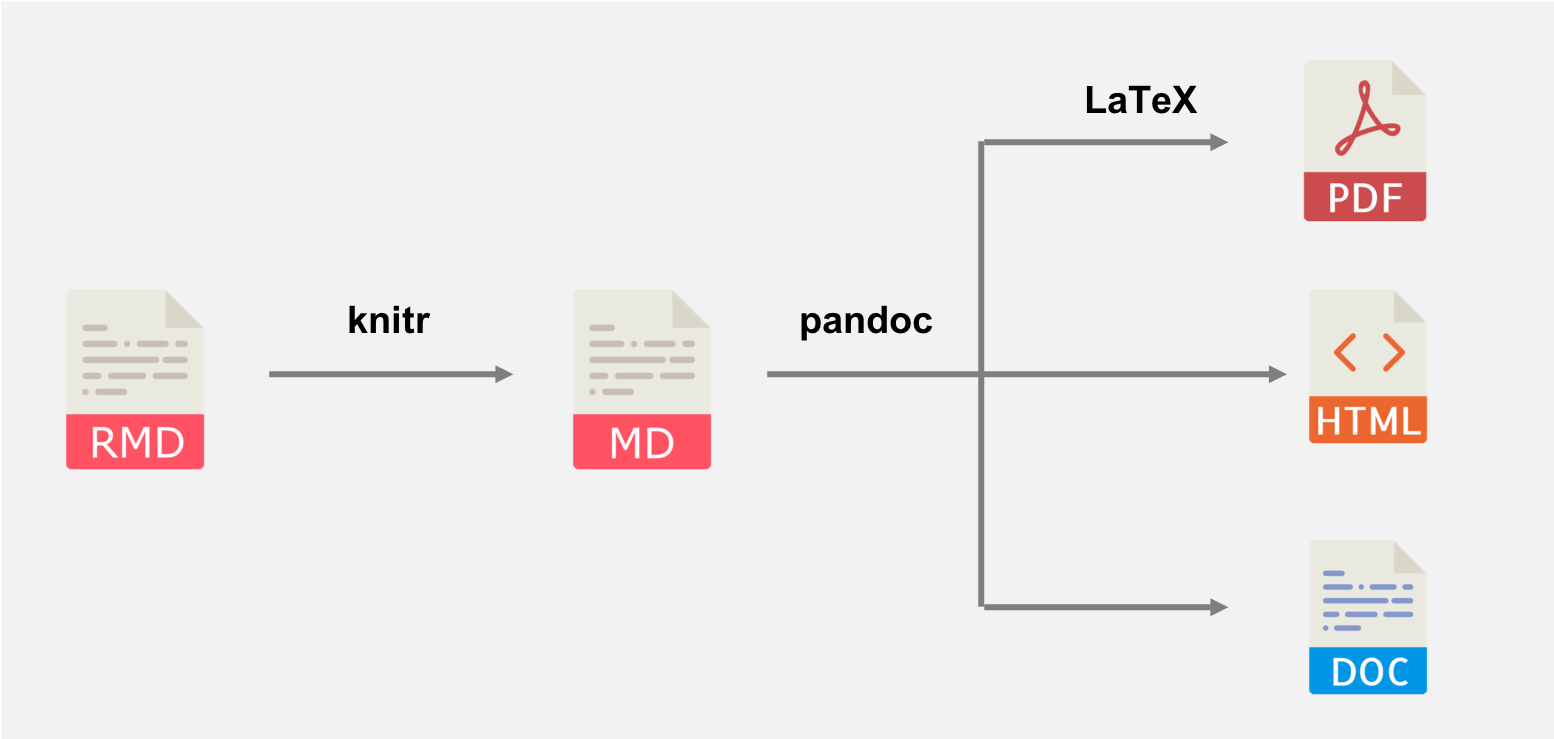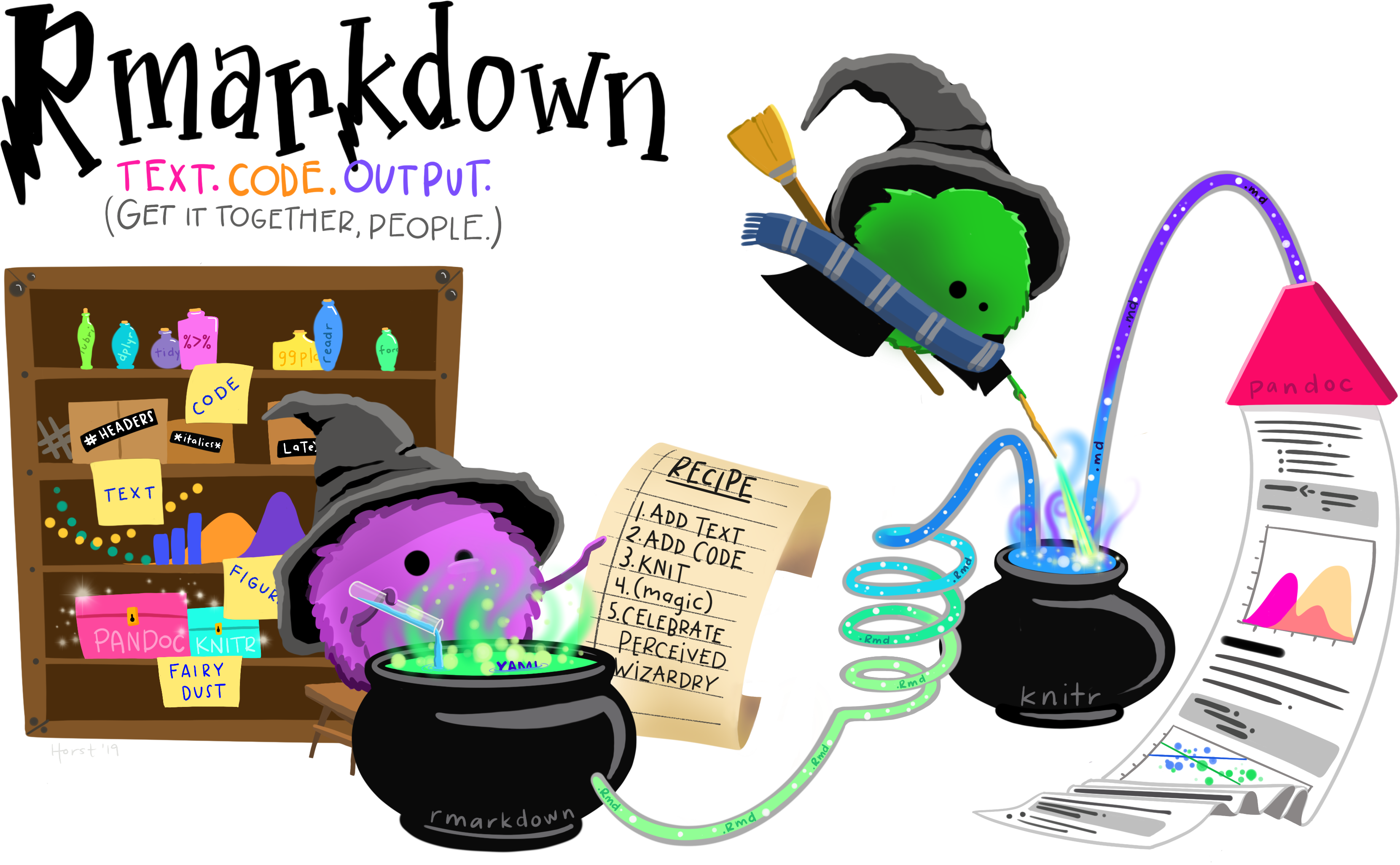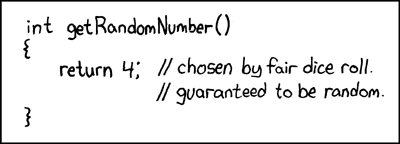A tour of {knitr} engines: {knitr} not only knits R
Christophe Dervieux
userR!2022 - 22nd of June
{knitr} in the the R Markdown workflow
knitr::knit() + Pandoc (+ LaTeX for PDF) = rmarkdown::render()

source: R Markdown Cookbook
First a bit of context regarding knitr in the R Markdown process. R Markdown is a tool to create some publication in several output formats by writing text and executable code together in the same document. knitr is the tool in the chain that will bring the literate programming feature by sewing source code and result with other text in the knitting process.
What is a {knitr} engine ?
Using R as example
```{r setup, include = FALSE}knitr::opts_chunk$set(echo = FALSE)``````{<engine> <label>, <keys = values>}<code content>```<engine>defines how the<code content>will be processed,<keys = values>are configurations for the engine,<label>is the name of the chunk
(equivalent tolabel = <label>).
Usually, R engine is used with knitr chunks to evaluate R code and showing source and outputs depending on providing options. Syntax looks this way with engine, a label and some option. An engine is the main component of knitr which will take code chunk content and process it so that source and results can be sewed in the document as text in the Markdown output.
There is more than just R !
Meet the other engines !
A subset of available engines
names(knitr::knit_engines$get())## [1] "awk" "bash" "coffee" "gawk" "groovy" "haskell" ## [7] "lein" "mysql" "node" "octave" "perl" "psql" ## [13] "Rscript" "ruby" "sas" "scala" "sed" "sh" ## [19] "stata" "zsh" "asis" "asy" "block" "block2" ## [25] "bslib" "c" "cat" "cc" "comment" "css" ## [31] "ditaa" "dot" "embed" "exec" "fortran" "fortran95"## [37] "go" "highlight" "js" "julia" "python" "R" ## [43] "Rcpp" "sass" "scss" "sql" "stan" "targets" ## [49] "tikz" "verbatim"Let's take a tour! 🚌
This principle is used for various engines and not just evaluating code chunk content with R.
Let's take a tour !
Processing chunk content as-is
Meet the verbatim engine
Include chunk content in a code block
.Rmd before knitting
Let's show an example of Rmd file content: ````{verbatim, lang = "markdown"}We can output arbitrary content **verbatim**.```{r}1 + 1```The content can contain inline code like`r pi * 5^2`, too.````.md after knitting
Let's show an example of Rmd file content: ````markdownWe can output arbitrary content **verbatim**.```{r}1 + 1```The content can contain inline code like`r pi * 5^2`, too.````Processing chunk content as-is
Meet the embed engine
Include file content in a code block
.Rmd before knitting
```{embed, file = "macros.js"}```.md after knitting
```jsremark.macros.scale = function(w, alt="") { var url = this; return '<img src="' + url + '" style="width: ' + w + ';" alt="' + alt + '" />';};remark.macros.scaleh = function(h, alt="") { var url = this; return '<img src="' + url + '" style="height: ' + h + ';" alt="' + alt + '" />';};```Processing chunk content as-is
Look at the asis engine
```{r}getRandomNumber <- function() { sample(1:6, 1)}``````{asis, echo = getRandomNumber() == 4}According to https://xkcd.com/221/,we just generated a **true** random number!```Processing chunk content as-is
Look at the asis engine
For getRandomNumber() != 4
```rgetRandomNumber <- function() { sample(1:6, 1)}```For getRandomNumber() == 4
```rgetRandomNumber <- function() { sample(1:6, 1)}```According to https://xkcd.com/221/,we just generated a **true** random number!Adding dependencies
Include CSS and JS easily in HTML
```{css, echo=FALSE}/* Some CSS code that will will be included in HTML document a `<style>` tag. */``````{js, echo=FALSE}// some JS code that will be included in HTML document in a`<script>` tag.```Useful to customize output directly from the Rmd file without external resource
Running other tools than R
Some built-in support
```{python}import osos.env``````{stata}sysuse autosummarize``````{bash}ls *.Rmd | head -n 5``````{perl}$test = "jello world";$test =~ s/j/h/;print $test```Chunk content is passed to the tools through system2()
Running other tools than R
Extend using exec engine
Using node CLI (which require .js extension for scripts)
```{exec, command='node', engine.opts = list(ext = ".js")}function Display(x) { console.log(`Your number is ${x}`); }Display(100);``````javascriptfunction Display(x) { console.log(`Your number is ${x}`); }Display(100);``````## Your number is 100```More in knitr-examples repo: 124-exec-engine.Rmd
The exec engine allows to execute an arbitrary command on the code chunk
content, optionally with arguments. If any, they are passed to engine.opts and
they could be one of the following:
The exec engine allows to execute an arbitrary command on the code chunk
content, optionally with arguments.
In your Rmd file
Working with interoperability
More engines powered by other 📦
- Use the
sqlengine to run queries using DBI on compatible databases - Use the
pythonengine with reticulate to work seemlessly with R and Python chunks together - Use the
scssorsassengine to process a chunk content with sass package to insert a CSS in HTML - Use the
bslibengine to add rules to bslib themes withing Rmd
Some R packages are great to work with other tools like DBI for SQL queries, reticulate for working with Python from R, sass to work with SASS or bslib to customize Bootstrap website. knitr engines can be integrated with other Packages to bring more feature from within a Rmd document.
Extending {knitr} with custom engines
Any package can provide custom way to process chunk content
- glue has a
glueengine to process chunk content as if passed toglue::glue()function - texPreview has a
texpreviewengine to render TeX snippet from code chunk, in non-LaTeX output document - targets offers a
targetsengine so that literate programming can be used to create a targets workflow (Target Markdown) - d3 has a
d3engine where chunk content will be processed with r2d3
Extending {knitr} with custom engines
How to create a new engine ?
knitr::knit_engines$set(foo = function(options) { # the source code is in options$code; just do # whatever you want with it})- Use
knit_engines$set()to register by name - All knitr options are passed to the engine
- Code chunk content is in
options$code
Extending {knitr} with custom engines
How to create a new engine ?
This engine will take the chunk content and make it upper case.
knitr::knit_engines$set(upper = function(options) { code <- paste(options$code, collapse = "\n") # Allow to hide result if (options$results == 'hide') return() # Allow to prevent processing if (options$eval) {} toupper(code) } else { code }})```{upper}Hello, **knitr** engines!```
HELLO, **KNITR** ENGINES!Extending {knitr} with custom engines
How to create a new engine ?
A custom py engine to run python
knitr::knit_engines$set(py = function(options) { code <- paste(options$code, collapse = '\n') out <- system2( 'python', c('-c', shQuote(code)), stdout = TRUE ) knitr::engine_output(options, code, out)})```{py}import osprint(os.environ.get('USERNAME'))```
```pyimport osprint(os.environ.get('USERNAME'))``````## chris```https://bookdown.org/yihui/rmarkdown-cookbook/custom-engine.html
knit_engines is the way to register an engine by name for knitr to know it is available. Full set of options is passed and options$code contains the chunk content. Do what you need with that to process it and outputting a what will be sewed in the document.

